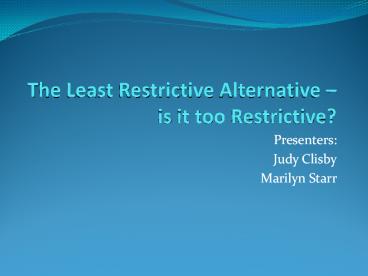The Least Restrictive Alternative is it too Restrictive - PowerPoint PPT Presentation
1 / 13
Title:
The Least Restrictive Alternative is it too Restrictive
Description:
Origins of the LRA. Perlin (2000) The LRA found ' ... The side effects may be impotence, or tiredness, or tremor, or restlessness to name just a few. ... – PowerPoint PPT presentation
Number of Views:46
Avg rating:3.0/5.0
Title: The Least Restrictive Alternative is it too Restrictive
1
The Least Restrictive Alternative is it too
Restrictive?
- Presenters
- Judy Clisby
- Marilyn Starr
2
Presentation Outline
- Background to the Least Restrictive Alternative
(LRA) - Case Examples
- Discussion
3
Origins of the LRA
- Perlin (2000)
- The LRA found constitutional life in the USA in
- Lessard v Schmidt 1972. The Wisconsin Federal
Court held that even where dangerousness and
mental illness are present, a person can be
involuntarily hospitalised only as a last resort.
A person could not be deprived of their liberty,
if there were less drastic means of achieving the
same goal (p1013).
4
LRA A Definition
- Least restrictive or intrusive treatment in the
least restrictive environment - 2 variables, environment and voluntariness
- How do we define restrictive/intrusive treatment?
5
Hierarchy of Restrictiveness
- Involuntary, Seclusion Restraint
- Involuntary admission, secure ward
- Involuntary admission, open ward
- Voluntary admission, open ward
- Involuntary treatment, community
- Voluntary treatment, community
6
Case Examplars
- There are times when consumers, who feel that
they are unsafe, attend a mental health facility
seeking a safe place to be. In this situation, a
consumer may feel safer if they are involuntary
patients in a locked facility, because in this
situation they know they are unable to harm
themselves..
7
Case Exemplars
- Using the hierarchy outlined above, people in
this situation would be seen as receiving the
most restrictive care that is, involuntary
treatment in a locked ward. - From the consumers perspective being involuntary
and in the locked ward is less restrictive
because the consumer feels safe.
8
Case Examplar 2
- There may be other occasions when the consumers
status on the ward is ambiguous. The consumer
may have been admitted as a voluntary patient,
but knows that refusal of treatment or an attempt
to leave the facility will in fact mean that
their status will change to involuntary. They
are voluntary, but they are de facto involuntary. - On these occasions, consumers may prefer to
retain their involuntary status because this
would mean at least that their status would be
reviewed by a body such as the Mental Health
Review Tribunal. Of course at the same time,
even with the restrictions, the consumer may feel
better about the admission because they are
voluntary.
9
Case Examplar 2
- Using the hierarchy outlined above, consumers who
are involuntary, even in an open ward, would have
been considered to have been at the highly
restrictive end of the continuum. Service
providers may argue that by admitting consumers
as voluntary patients whenever possible, they are
acting in accordance with the least restrictive
alternative. - From the consumers perspective, involuntary
status may in fact be preferable because it would
mean access to Tribunal review and so would be,
from their perspective, more restrictive. Other
consumers may in fact find it less restrictive to
be admitted voluntarily. The key variable in
this example is consumer choice.
10
Case Examplar 3
- Imagine a situation where there are severe side
effects to the medication. The side effects may
be impotence, or tiredness, or tremor, or
restlessness to name just a few. Sometimes, the
case manager may not understand the impact the
side effects are having on the consumers life.
Even if the treating team does know that the
consumer is experiencing side effects to the
medication, they may believe that the consumer
must be treated involuntarily in the community
because the consumer may be a danger to self or
others when unwell.
11
Case Exemplar 3
- Using the hierarchy with voluntariness and
environment as two measures of restrictiveness,
it would seem that in this example, the consumer
is receiving a service that is less restrictive
than either of the examples above, as treatment
is being provided in the community, even though
this is involuntary. - Yet the consumer may consider the treatment to be
highly restrictive because the medication affects
the ability to live a normal life. The consumer
may also believe that concerns that are expressed
about medication are not being heard.
12
Case examplars - conclusion
- In all case examples, the consumer viewed the
restrictivity of their experience in a different
way from the hierarchy of restrictiveness. - The determinants of restriction were different
for consumers, and were far broader than
environment and voluntariness. - These examplars demonstrate that the most
important determinants of restriction are
consultation and choice.
13
Autonomy
- The aim of mental health intervention is
promotion of the autonomy of the individual. - The LRA is a mechanism for preserving autonomy.
- For this reason, the hierarchy of restrictiveness
must wherever possible respect the choices of the
person receiving treatment.































